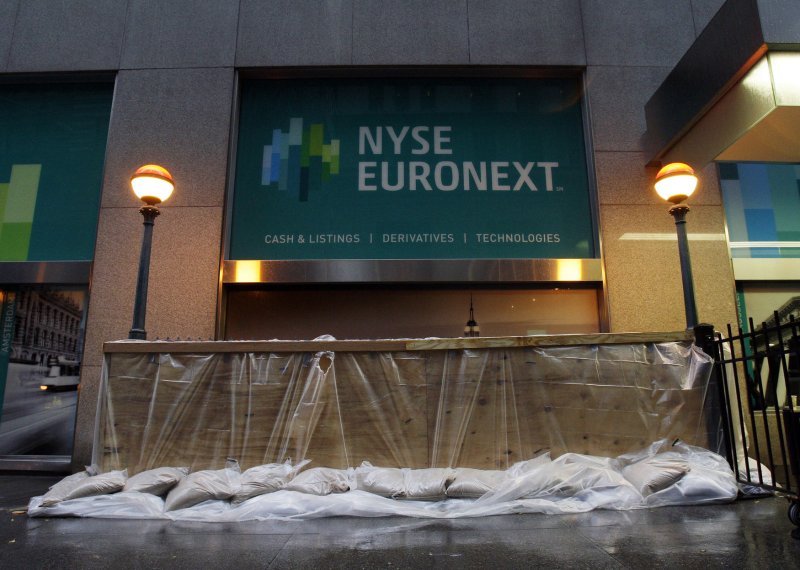Areas around the New York Stock Exchange are protected from floodwaters with sandbags on Wall Street as Hurricane Sandy approached New York City Monday. UPI/John Angelillo |
License Photo
Wall Street is operating on real time Wednesday.
The New York Times made the immediacy of Hurricane Sandy's impact a moment-to-moment event, cataloging the decision on whether or not to reopen markets in a real-time blog. That is to say as events unfolded, the newspaper plunked them out of the stratosphere and post them on the Internet.
It is that unusual for markets to shut down for two-consecutive days in what can be called an unscheduled stop.
So much of the market is balanced on perception and confidence -- or the lack thereof -- that a sudden surge in trading as markets re-open is an event unto itself. Turning the lights back on after two days illuminates more than the buildings downtown. Brokers in Singapore, Paris and London are poised to pick up the phone or click on a computer's mouse.
In real terms, this involves a financial district that for the first time in memory -- maybe since the Revolutionary War -- includes pod-like lines of pillow-shaped sandbags arranged around buildings to slow floodwaters.
Wednesday is also the day of finger-pointing. An unfortunate pattern of behavior, perhaps, but there's big money behind the question of why isn't the emergency back-up system up to speed.
In a part of town where decision-makers don't get their feet wet no matter what circumstances come visiting -- a few penthouse Joes, in other words -- a delay in the 7 a.m. cup of tea could mean someone's job. Don't tell me about gale-force winds, Jeeves. That kind of excuse is unacceptable.
But problems persist.
"Right now there are a lot of connectivity problems," Larry Leibowitz, the chief operating officer of the NYSE Euronext, said Tuesday.
The last weather-related two-day stock exchange closure occurred 124 years ago, so anyone prepared for a 100-year weather event was theoretically on the wrong side of ready. The last unexpected halt to trading occurred after the September 11, 2001, terrorists attacks on the World Trade Center. That derailed trading for four consecutive days.
While the finger-pointing warms up, it is also critical that the restart go well, Matt Samelson, a principle at Woodbine Associates told the Times. "You don't want a false start," he said.
This is not so much the Super Bowl so much as a launch of a space shuttle. A false step does nobody any good and if the back up system was insufficient, there's concern the reboot could be a kick in the rear.
Where's the pressure?
"It's incredibly important to open these markets. It says New York is open for business," said Miranda Mizen, the head of equity research at TABB Group.
In international markets Wednesday, the Nikkei 225 index in Japan added 0.98 percent while the Shanghai composite index in China gained 0.32 percent. The Hang Seng index in Hong Kong rose 1 percent while the Sensex in India gained 0.4 percent.
The S&P/ASX 200 in Australia added 0.7 percent.
In midday trading in Europe, the FTSE 100 index in Britain fell 0.18 percent while the DAX 30 in Germany rose 0.59 percent. The CAC 40 in France added 0.17 percent while the Stoxx Europe 600 gained 0.15 percent.















